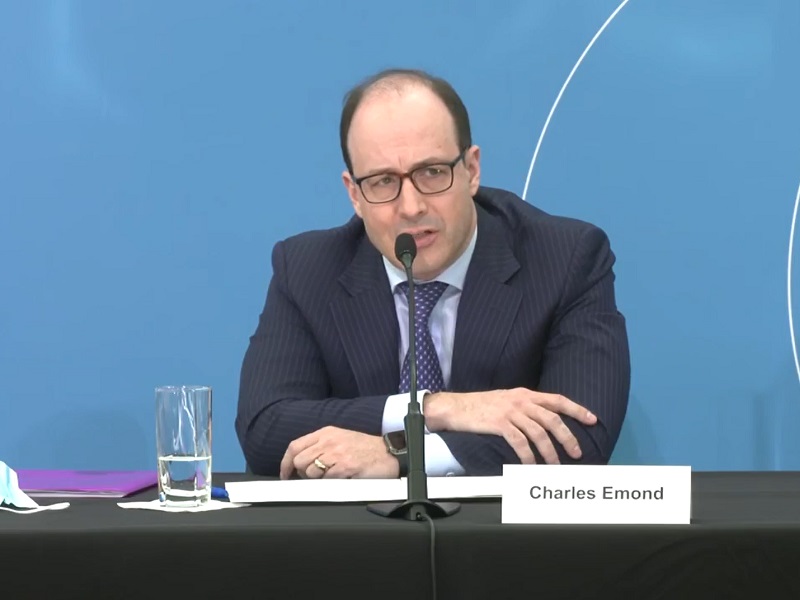
The Caisse de dépôt et placement du Québec generated average returns of negative 5.6 per cent in 2022.
“The year 2022 provided an environment filled with several challenges, with spiking inflation, historic interest rate hikes by central banks and rising geopolitical tensions,” said Charles Emond, the Caisse’s president and chief executive officer, during a press briefing this morning.
The investment organization finished the year with $402 billion in net assets, down from $419.8 billion at the end of 2021. The $16.2 billion decline was the first experience by the Caisse since 2008.
Read: Caisse reporting negative 7.9% return for first half of 2022
According to Emond, the majority of the losses occurred between January and June. “The first half of the year was marked by the worst concurrent correction in the stock and bond markets in 50 years, which posted negative returns from negative 10 per cent to negative 30 per cent.”
However, the mood of the markets picked up during the second half of the year, as investors became more comfortable with the approach taken by central banks regarding interest rate hikes, said Emond. “Things picked up again mid-June. . . . We had more volatility in the second half of the year, but we were more dynamic.”
The majority of the losses stemmed from the Caisse’s traditional public markets portfolio. Its allocations to fixed income lost 14.9 per cent during the year while public equities lost 11.3 per cent. However, the public equities portfolio’s results were buoyed by the strong performance of its oil and tobacco sector holdings. They were also strengthened by the performance of technology companies the previous year. During 2021, the value of technology stocks in the public equities portfolio, which were underweight, grew enormously, exceeding the 10 per cent portfolio benchmark.
In response, the Caisse liquidated its portfolio of the excess in early 2022, before values cratered. “We’re now in the the opposite position, needing to increase our allocation to the tech giants,” said Emond.
Read: Caisse invests in B2B technology platform, CPPIB to build four London office towers
The investment organization’s allocations to alternative asset classes made gains during the year, with the infrastructure portfolio returning 11.5 per cent. According to Emond, these gains were driven by allocations to energy and transportation assets.
During a question period following the press briefing, Emond was pressed for information about the Caisse’s allocation to the renewable energy infrastructure company Azure Power Global Ltd., in which it secured a 50.9 per cent stake in 2020. Since then, its values have dropped by 73.75 per cent. The majority of the losses followed whistleblower reports accusing several executives of misconduct. This week, the company also received an extension from the New York Stock Exchange allowing it to delay filing its results for 2022 until July 2023, without being de-listed.
“It’s too soon to speak of losses,” said Emond. “It’s still listed on the stock market. It still has a price,” said Emond. “In these situations, all options are still on the table.”
Read: Class action suit against solar business backed by Caisse, OMERS seeking lead plaintiff
The Caisse’s $77-billion real estate portfolio returned 12.4 per cent. During the briefing, Nathalie Palladitcheff, president and CEO of Ivanhoé Cambridge, said the performance was bolstered by allocations to logistics, residential and life sciences properties.
She credited the strength of the asset class during the year — which had annualized returns of 2.3 per cent on a five-year basis — to the strategic repositioning of its investments in recent years. “More than half of the returns came from investments that are less than five years old.”
Private equity returned 2.8 per cent during the year, growing by 60 per cent through 2020 and 2021. The performance was strengthened by the fund’s provincial bias, with its Quebec-based holdings reaching $78.6 billion.
During the question period, Emond was asked to clarify what led the Caisse to enter the digital currency sector with a US$400 million in the now-defunct cryptocurrency earning and borrowing platform Celcius. “It was not a good investment decision. No one was happy with it . . . We came in too soon. We knew what we wanted to transform in the company. We didn’t get those changes made. . . . The possibilities were good, but we deviated from our typical venture capital strategy.”
The Caisse won’t re-enter the cryptocurrency space and is pursuing legal action, he added. “We put in legal notice on false representation on the financial situation of the company.”
And going forward, Emond’s outlook for 2023 is somewhat negative. “Interest rates will need to go a little bit higher before inflation will fall. I think that 2023 will be a year of transition. It will bring a lot of challenges.”
Read: Caisse investing in crypto lending platform, aligning corporate lending program with ESG performance
